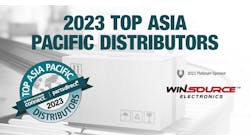Download this article in PDF format.
Made up of the countries that are situated in and around the western portion of the Pacific Ocean, the Asia-Pacific or “APAC” region is home to a number of electronics distributors that serve a worldwide customer base from their strategically-situated facilities.
As a rule, most countries located throughout eastern and southern Asia—particularly those that touch the Pacific Ocean—and Oceania are usually considered APAC countries. However, the actual list of APAC countries can vary depending upon the context. For the most part, however,
China is the largest country in the APAC region. For example, unless the list also includes Canada, Russia or the U.S., China is generally considered the largest APAC country, followed by Australia, India, Indonesia and Mongolia.
Within the APAC region, the largest electronics distributors are concentrated in China, Singapore and Hong Kong. In China, Win Source, iCEasy Electronics, THJ (HK) Technology Limited, and Kehuite Technology Development (HK) Ltd., rank among the largest suppliers of electronics equipment, products and supplies. In Singapore, Supreme Components International Pte Ltd is the largest electronics distributor. In Hong Kong some of the largest suppliers include JT Tech Electronics Ltd., XingHua International, New Strength Electronic Co. and Fairstock HK Limited.
Overcoming Challenges, Grabbing New Opportunities
Like most of the world’s electronics distributors, those based in the APAC region have faced many of the same pressures that suppliers worldwide have been dealing with over the last two-and-a-half years. The ongoing pandemic, shutdowns, labor constraints, supply chain disruptions and worldwide chip shortage are just some of the biggest roadblocks that these companies have been working to overcome.
Despite these challenges, APAC’s electronics distributors are also leveraging new business opportunities and responding to high demand for their products, and particularly from sectors like automotive manufacturing. In APAC Electronics Industry Expansion Moderates Amidst Pricing Pressures, IHS Markit’s Rajiv Biswas says expansion in the electronics sector is continuing, but notes that growth momentum has gradually moderated during the first half of 2022, with new orders having slowed.
“The global electronics industry continues to struggle with protracted supplier delivery times and pricing pressures for critical materials, although supplier delivery times have shown gradual improvement in recent months,” Biswas writes. Overall, the global electronics industry has shown positive expansion since mid-2020, as the pandemic continues to drive “strong demand for consumer electronics for remote working and home entertainment,” Biswas points out.
“However, the pace of expansion has shown some moderation in the first half of 2022,” he adds. “Nevertheless, electronics exports have continued to show strong growth in a number of major APAC electronics manufacturing hubs during the first half of 2022.”
New Free Trade Agreements
The introduction of several free trade agreements in APAC could help stabilize the market further in the coming months. “As Asia-Pacific jurisdictions continue to expand their existing free trade networks, companies can often get a boost from the considerable import duty relief available in the region,” KPMG points out.
In 2020, for example, 15 jurisdictions in the region signed the Regional Comprehensive Economic Partnership Agreement (RCEP) with 10 members of the Association of Southeast Asian Nations, making it the world’s largest free trade agreement. The RCEP is expected to come into force in 2022. The comprehensive free trade agreement covers trade in goods, trade in services, investment, economic and technical cooperation, and creates new rules for electronic commerce, intellectual property, government procurement, competition, and small- and medium-sized enterprises.
In addition, the Comprehensive and Progressive Agreement for Trans-Pacific Partnership (CPTPP), signed in 2018, is now in force in Canada, Australia, Japan, Mexico, New Zealand, Singapore and Vietnam, and pending ratification in Brunei, Chile, Malaysia and Peru.
“The potential benefits of these agreements go beyond direct reductions in customs duties,” KPMG explains. “They also provide opportunities for companies to rethink their supply chains, enter into new markets, make pricing more competitive, and gain access to a larger spectrum of suppliers, components and raw materials.”
Continued Expansion Ahead
Global electronics manufacturers continue to face intense cost pressures, according to IHS Markit’s most recent survey data. Biswas says increases in international raw material prices and rising supplier fees are both contributing to sustained inflationary pressures. “Overall, input costs rose at one of the steepest rates in the series history,” he writes, “with the input prices PMI sub-index at 74.0 in June, albeit having eased slightly from recent peaks.”
Looking ahead, Biswas says that the APAC electronics industry is on track for “continued expansion” based on the most recent S&P Global Electronics PMI Survey. Lengthy production backlogs for some key electronics products, notably semiconductors, will be an important factor supporting electronics output during the second half of 2022, he writes, but growth momentum has been moderating in recent months.
“Slowing growth momentum in the key markets of the US and EU are also expected to act as a drag on electronics new orders during the second half of 2022,” Biswas adds.
Bloomberg’s Brendan Murray says the publication’s latest update shows that a nascent production revival in China has reduced delivery times for factories. Shanghai’s reopening was the biggest driver, he reports, and now many Asian tech firms and auto makers are facing “fewer supply challenges, but logistical hurdles remain for some and may extend to 2023.”









